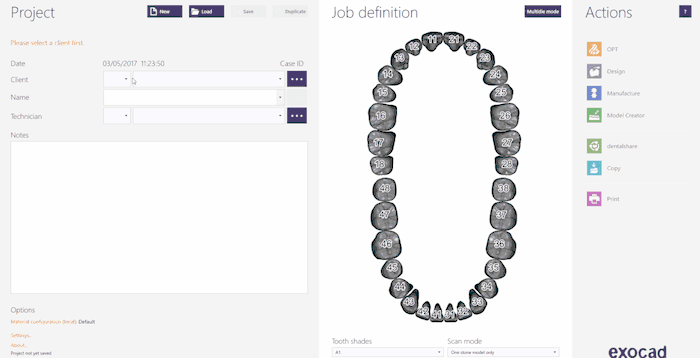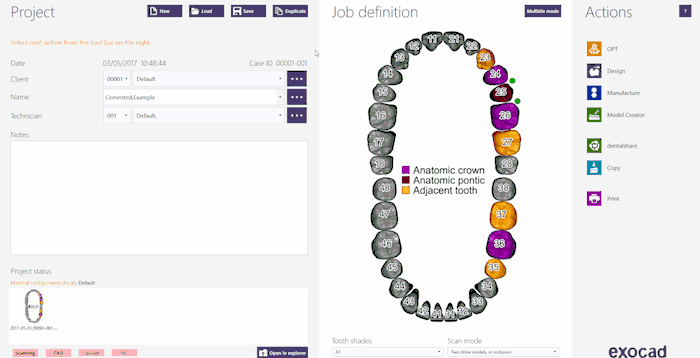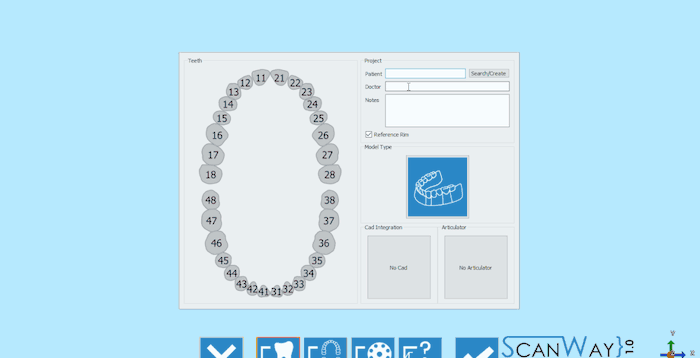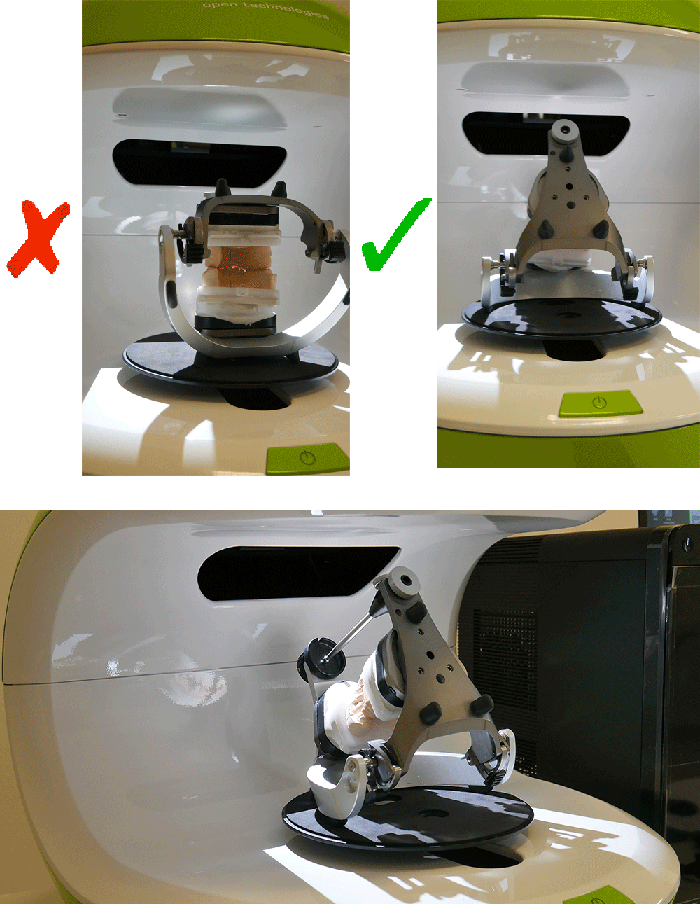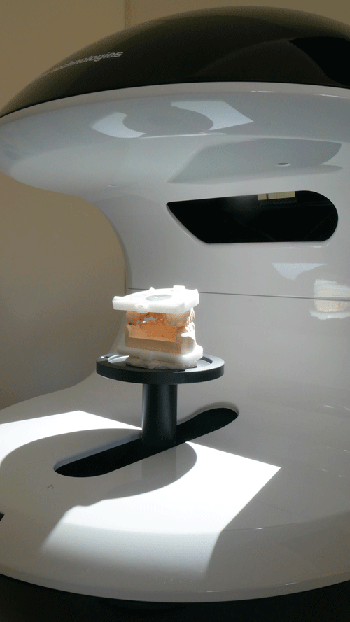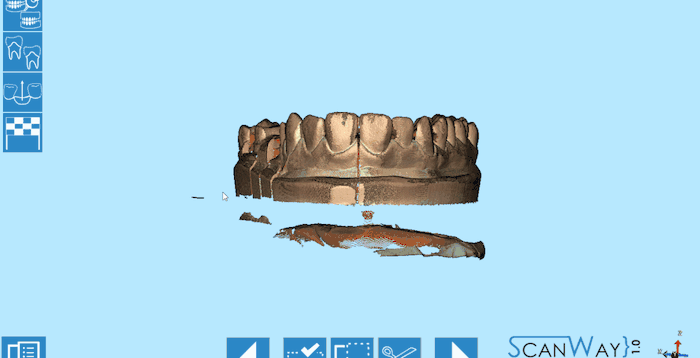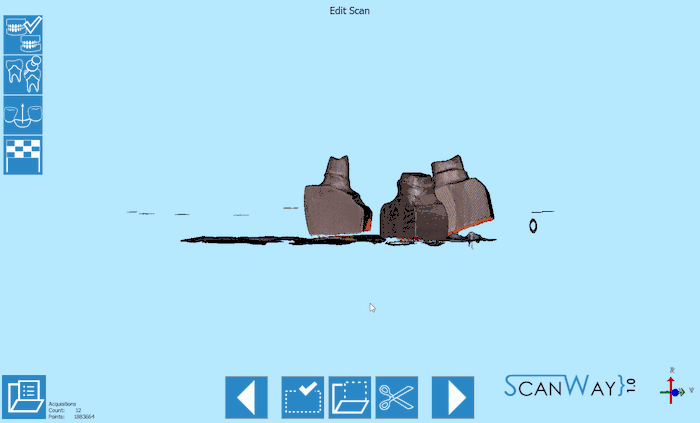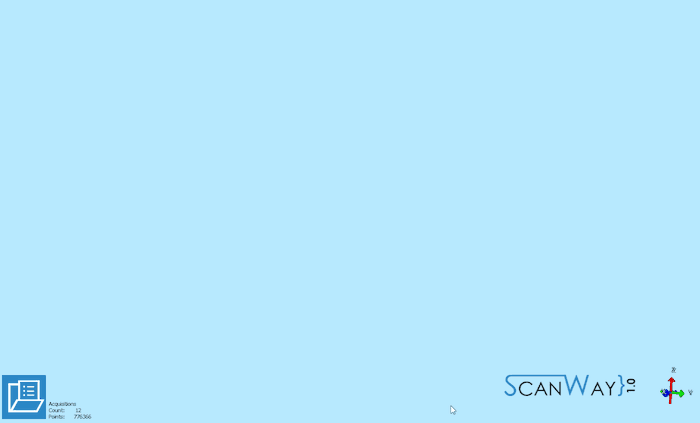Difference between revisions of "ExamplesCemented"
| Line 40: | Line 40: | ||
| − | == | + | ==Step 1: Articulator Scanning== |
The first step of any project that as been set to have both jaws, is the Articulator Scan. | The first step of any project that as been set to have both jaws, is the Articulator Scan. | ||
| Line 66: | Line 66: | ||
Click {{Inline button|nextAction.png}} to access the second step of the wizard. | Click {{Inline button|nextAction.png}} to access the second step of the wizard. | ||
| − | == | + | ==Step 2: Lower Model== |
| − | The first step of any project that as been set to have both jaws, is the Lower Model Scan. | + | The first step of any project that as been set to have both jaws, is the Lower Model Scan. All steps, except for the articulator one, include two sub-steps: the actual scan and the edit of the acquired image. |
===Scan Step=== | ===Scan Step=== | ||
| Line 86: | Line 86: | ||
===Edit Step=== | ===Edit Step=== | ||
| + | This step allows to edit the aquired image; for detailed information on all the available options in this step visit the [[Edit|Edit Tools]] page. | ||
| + | The image at this step can be both edited or trimmed. At this stage it is actually important not to edit too much the image or cutting big chunks of information, since it would make it more difficult for the software to calculate the automatic alignment of the object to its reference. | ||
| + | |||
| + | The edit of the image can be carried out using the selection tools. | ||
| + | |||
| + | [[File:edit_seltools.gif]] | ||
| + | |||
| + | On the other hand, trimming gets very easy when the '''cut base''' tool is used. | ||
| + | |||
| + | [[File:cut-base.png]] | ||
| + | |||
| + | When you are satisfied with the result click {{Inline button|nextAction.png}} to access the next wizard step. | ||
| + | |||
| + | ===Step 3: Upper Model=== | ||
| + | |||
| + | The upper model Scan, like the lower model, requires the user to undergo two steps. | ||
| + | |||
| + | ===Scan Step=== | ||
| + | |||
| + | Place the upper model on the model holder and click the '''Scan Button'''{{Inline button|scanAction.png}}. Once the scan is finished the result will be shown. | ||
| + | |||
| + | [[File:upper-model-steps.png]] | ||
| + | |||
| + | As before, if the reference rim is not placed on the model holder, the software will show the relevant message. | ||
| + | |||
| + | Click {{Inline button|nextAction.png}} to access the edit step for the Upper model. | ||
| + | |||
| + | ===Edit Step=== | ||
| + | |||
| + | The upper model can still be edited as shown for the lower model. This time, we will edit the image using a different selection tool. | ||
| + | |||
| + | [[File:edit-upper.gif]] | ||
| + | |||
| + | When you are satisfied with the result click {{Inline button|nextAction.png}} to access the next wizard step. | ||
| + | |||
| + | ==Save and Align== | ||
| + | |||
| + | Immediately after having pushed the {{Inline button|nextAction.png}} button, the software saves and tries to align automatically the scanned items to their reference. | ||
| + | |||
| + | [[File:save_and_align.gif]] | ||
| + | |||
| + | To learn more on the automatic alignment and the manual procedure visit our [[Align|Alignment Interface]] page. | ||
| + | |||
| + | ==Step 4: Dies Scan== | ||
| + | |||
| + | The steps necessary to succesfully scan the dies vary depending on the scanning method that the user chooses to apply: the use of the multidie plate or the custom set-up. | ||
| + | |||
| + | ===With Multidie=== | ||
| + | |||
| + | This method is applied by default by the software. It implies that the user will put the dies on the multidie plate in the position shown by the software, which will make each die immediately recognisable and cut the steps of the wizard. | ||
| + | |||
| + | ;Definition: As mentioned, the position of the dies in the multidie plate is pre-established by the software. The multidie order is based on the Universal tooth numbering, starting from the last element of the first quadrant and following in a clock-wise order. Therefore the die that needs to be placed in the central element will always be the one closest to the last element of the firts quadrant. If there are more than 9 dies, a second definition step will be shown. | ||
| + | |||
| + | {{Screenshot|wizard-multidie-def.png}} | ||
| + | |||
| + | Click {{Inline button|nextAction.png}} to access the multidie scan step. | ||
| + | |||
| + | ;Scan: The multidie scan interface is similar to the others step we just explained, except for the multidie reference that is kept as a reminder on the right side of the window, under the live view. To proceed click the '''Scan Button'''{{Inline button|scanAction.png}}. Once the scan is finished the result will be shown. | ||
| + | |||
| + | [[File:multidie-steps.png]] | ||
| + | |||
| + | Click {{Inline button|nextAction.png}} to access the edit step for the multidie scan. | ||
| + | |||
| + | ;Edit: The edit step offers the same tools we saw in previous steps. In this case, more than one tool may need to be applied. | ||
| + | |||
| + | [[File:edit-multidie.gif]] | ||
| + | |||
| + | When you are satisfied with the result click {{Inline button|nextAction.png}} to access the next wizard step. | ||
| + | |||
| + | ;Alignment: After being edited the dies get aligned to their references. The result is then showed on the monitor. To learn how to change, fix or redo the alignment check the [[Align|Alignment Interface]] page. | ||
| + | |||
| + | [[File:dies-autoalign.gif]] | ||
| + | |||
| + | ===Custom Set-Up (Without Multidie)=== | ||
| + | |||
| + | The user can also decide to scan the dies in a custom order, for instance if he needs to scan the dies on the model base. To access the custom set- up definition, click on the {{Inline button|customSetupAction.png}} icon when the software presents the multidie definition. | ||
| + | |||
| + | {{Screenshot|custom-setup-dies.png}} | ||
Revision as of 14:32, 3 May 2017
In this page will be followed and explained the wizard for scanning 2 models in occlusion with 3 dies (2 upper and 1 lower).
Contents
Project definition starting from Exocad
To create this project in Exocad, click on the DentalDB icon in your desktop. The project manager will open.
Fill in the project information, the kind of restoration that needs to be designed and the extra parameters. For this kind of project make sure that the Scan Mode is set on Two stone models in occlusion.
For further information on how to create projects in Exocad, visit the specific page on the Exocad Wiki!
Here is the project definition for our demo project:
Once the project has been defined just click OPT in the Actions section to launch the scanning software.
The first thing the scanning software shows is the project created in Exocad, if the project is correctly defined click the Accept Button ![]() .
.
Project definition starting from ScanWay
All projects can be defined in the scanning software as well, regardless the CAD that will be later on used to design.
Launch the scanning software double-clicking on the ScanWay icon on your desktop. The Welcome Page will open; to create the project click on the first icon.
For detailed information on how to define a project visit the specific page: Create a New Project.
Here is the definition of our demo project:
Both the project definitions described lead to the same wizard, which will be now followed step by step.
Step 1: Articulator Scanning
The first step of any project that as been set to have both jaws, is the Articulator Scan.
For Articulator scan it is not necessarily meant that an Articulaotr needs to be scanned; the required scan is the acquisition of the occlusion either using the articulator on its specific support or putting the two models in occlusion on the model holder
If the user needs to scan an articulator, we suggest to tilt it backwards, to be able to get as information as possible. This is just a suggestion as not all articulators can be tilted.
In the live view of the scanning interface you can actually see that if the articulator is standing straight it will be difficult to acquire the occlusion properly.
On the other hand, as previously mentioned, it is also possible to scan the two models in occlusion on the normal model holder held together with rubber bands or wax if necessary.
Once the objects have been placed in the scanner (either the articulator or the models one on top of the other), the scan can be started with the Scan Button![]() . Once the scan is finished the result will be shown.
. Once the scan is finished the result will be shown.
For further information on the other available functions check the Scan Interface page.
Click ![]() to access the second step of the wizard.
to access the second step of the wizard.
Step 2: Lower Model
The first step of any project that as been set to have both jaws, is the Lower Model Scan. All steps, except for the articulator one, include two sub-steps: the actual scan and the edit of the acquired image.
Scan Step
Place the lower model on the model holder and click the Scan Button![]() . Once the scan is finished the result will be shown.
. Once the scan is finished the result will be shown.
This scan has been performed with the Reference Rim. Everytime the user launches a scan for models, dies or markers and the software recognises the reference rim has not been used the following message shows.
The user can therefore decide wether to cancel the scan, put the reference rim on the model holder and start a new scan, or to scan without using the reference rim. For information on the reference rim visit the Accessories page.
Click ![]() to access the second part of the Lower model step.
to access the second part of the Lower model step.
Edit Step
This step allows to edit the aquired image; for detailed information on all the available options in this step visit the Edit Tools page.
The image at this step can be both edited or trimmed. At this stage it is actually important not to edit too much the image or cutting big chunks of information, since it would make it more difficult for the software to calculate the automatic alignment of the object to its reference.
The edit of the image can be carried out using the selection tools.
On the other hand, trimming gets very easy when the cut base tool is used.
When you are satisfied with the result click ![]() to access the next wizard step.
to access the next wizard step.
Step 3: Upper Model
The upper model Scan, like the lower model, requires the user to undergo two steps.
Scan Step
Place the upper model on the model holder and click the Scan Button![]() . Once the scan is finished the result will be shown.
. Once the scan is finished the result will be shown.
As before, if the reference rim is not placed on the model holder, the software will show the relevant message.
Click ![]() to access the edit step for the Upper model.
to access the edit step for the Upper model.
Edit Step
The upper model can still be edited as shown for the lower model. This time, we will edit the image using a different selection tool.
When you are satisfied with the result click ![]() to access the next wizard step.
to access the next wizard step.
Save and Align
Immediately after having pushed the ![]() button, the software saves and tries to align automatically the scanned items to their reference.
button, the software saves and tries to align automatically the scanned items to their reference.
To learn more on the automatic alignment and the manual procedure visit our Alignment Interface page.
Step 4: Dies Scan
The steps necessary to succesfully scan the dies vary depending on the scanning method that the user chooses to apply: the use of the multidie plate or the custom set-up.
With Multidie
This method is applied by default by the software. It implies that the user will put the dies on the multidie plate in the position shown by the software, which will make each die immediately recognisable and cut the steps of the wizard.
- Definition
- As mentioned, the position of the dies in the multidie plate is pre-established by the software. The multidie order is based on the Universal tooth numbering, starting from the last element of the first quadrant and following in a clock-wise order. Therefore the die that needs to be placed in the central element will always be the one closest to the last element of the firts quadrant. If there are more than 9 dies, a second definition step will be shown.
Click ![]() to access the multidie scan step.
to access the multidie scan step.
- Scan
- The multidie scan interface is similar to the others step we just explained, except for the multidie reference that is kept as a reminder on the right side of the window, under the live view. To proceed click the Scan Button
 . Once the scan is finished the result will be shown.
. Once the scan is finished the result will be shown.
Click ![]() to access the edit step for the multidie scan.
to access the edit step for the multidie scan.
- Edit
- The edit step offers the same tools we saw in previous steps. In this case, more than one tool may need to be applied.
When you are satisfied with the result click ![]() to access the next wizard step.
to access the next wizard step.
- Alignment
- After being edited the dies get aligned to their references. The result is then showed on the monitor. To learn how to change, fix or redo the alignment check the Alignment Interface page.
Custom Set-Up (Without Multidie)
The user can also decide to scan the dies in a custom order, for instance if he needs to scan the dies on the model base. To access the custom set- up definition, click on the ![]() icon when the software presents the multidie definition.
icon when the software presents the multidie definition.
